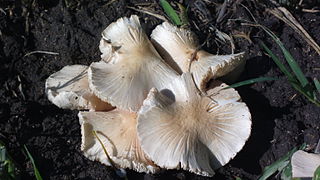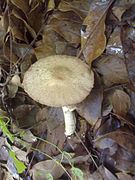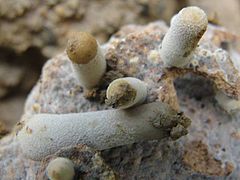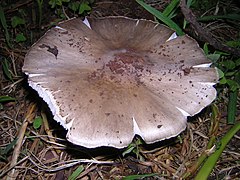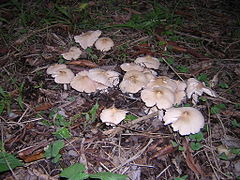Termitomyces
| Termitomyces | ||||||||||||
|---|---|---|---|---|---|---|---|---|---|---|---|---|

Termitomyces reticulatus |
||||||||||||
| Systematics | ||||||||||||
|
||||||||||||
| Scientific name | ||||||||||||
| Termitomyces | ||||||||||||
| R.Heim |
Termitomyces , also known as termite mushrooms , is a genus of mushroom mushrooms from the Rasling family. The genus produces around 30 species, including the largest agaric mushroom on earth: Termitomyces titanicus .
features
The fruiting bodies of many species become very large, with the species Termitomyces titanicus being the largest representative of the genus with bodies one meter in diameter. Termitomyces species form centrally stalked fruiting bodies, with a flat to bell-shaped hat , often hunched. The edges of the hat are a little to heavily torn in most species. Some species form points or spots on the surface of the hat or a ring on the stem . The size varies between species. As a rule, however, the genus produces very large fruiting bodies. Most of the species are edible mushrooms . In some regions of Africa the fruiting bodies of some species are economically important.
All species have in common the presence of pink spores and the root-like elongated stem ( pseudorhiza ), which is directly connected to the termite nest.
ecology
All species are in symbiosis with termites of the subfamily Macrotermitinae . Despite this connection, the spore transmission takes place through the fruiting bodies, whose umbrellas protrude over the termite mounds. The termites literally grow the fungus, plant mushroom gardens and use the fungus formations as food. The gardens are laid out in special chambers using excrement pills containing spores. The mycelium grows through the substrate (the accumulations of excrement) and after a few weeks the fungus begins to form vegetative nodules that serve as food for the termites.
Occurrence
Most species of the genus occur in the countries of southern Africa , including Namibia , Zambia and Tanzania . But there are also species in India , Colombia and the Philippines . All species grow exclusively out of or near termite mounds.
Systematics and types
The genus was first described by the French botanist Roger Heim in 1942.
Individual evidence
- ^ Tobias Frøslev: The genus Termitomyces. In: Burkina Faso. From MycoKey.com, accessed December 13, 2019.
- ↑ Georg Schön: Mushrooms - living beings between plants and animals. CH Beck, Munich 2005, ISBN 978-3-406-50860-8 .
- ↑ a b Ulrich G. Müller, Nicole M. Gerardo, Duur K. Aanen, Diana L. Six, Ted R. Schultz: The Evolution of Agriculture in Insects. In: Annual Review of Ecology, Evolution, and Systematics. Volume 36, 2005, pp. 563-595. DOI: 10.1146 / annurev.ecolsys.36.102003.152626
- ^ Roger Heim: Nouvelles études descriptives sur les agarics termitophiles d'Afrique tropicale. Archives du Muséum National d'Histoire Naturelle, 1942.

